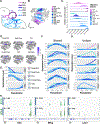A single-cell transcriptomic map of the developing Atoh1 lineage identifies neural fate decisions and neuronal diversity in the hindbrain
- PMID: 39106860
- PMCID: PMC12374751
- DOI: 10.1016/j.devcel.2024.07.007
A single-cell transcriptomic map of the developing Atoh1 lineage identifies neural fate decisions and neuronal diversity in the hindbrain
Abstract
Proneural transcription factors establish molecular cascades to orchestrate neuronal diversity. One such transcription factor, Atonal homolog 1 (Atoh1), gives rise to cerebellar excitatory neurons and over 30 distinct nuclei in the brainstem critical for hearing, breathing, and balance. Although Atoh1 lineage neurons have been qualitatively described, the transcriptional programs that drive their fate decisions and the full extent of their diversity remain unknown. Here, we analyzed single-cell RNA sequencing and ATOH1 DNA binding in Atoh1 lineage neurons of the developing mouse hindbrain. This high-resolution dataset identified markers for specific brainstem nuclei and demonstrated that transcriptionally heterogeneous progenitors require ATOH1 for proper migration. Moreover, we identified a sizable population of proliferating unipolar brush cell progenitors in the mouse Atoh1 lineage, previously described in humans as the origin of one medulloblastoma subtype. Collectively, our data provide insights into the developing mouse hindbrain and markers for functional assessment of understudied neuronal populations.
Keywords: Atoh1; CUT&RUN; DNA binding; brainstem; cerebellum; hindbrain; neural fate decisions; single-cell RNA sequencing; spatial transcriptomics.
Copyright © 2024 The Authors. Published by Elsevier Inc. All rights reserved.
Conflict of interest statement
Declaration of interests R.S.D. is a paid consultant for AstraZeneca. H.Y.Z. is a member of the Board of Regeneron, co-founder of Cajal Neuroscience, and on the science advisory board of the Column group. This is work in the Zoghbi Lab and has not been licensed anywhere. The work in this paper has no connection to any of the consulting or companies named here.
Figures







References
Publication types
MeSH terms
Substances
Grants and funding
LinkOut - more resources
Full Text Sources
Molecular Biology Databases

